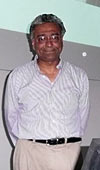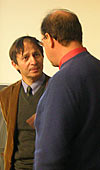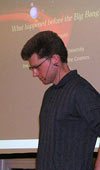Living Reviews Anniversary Lectures
In 2008, Living Reviews in Relativity is celebrating its 10th anniversary with a series of lectures by distinguished authors in the Berlin/Potsdam area. Most recent information on speakers, venues and dates is posted here.
May
Prof. Dimitrios Psaltis, University of Arizona, Tucson, AZ
- Topic: Probes and Tests of Strong-Field General RelativityIn contrast to gravity in the weak-field regime, which has been subjected to numerous experimental tests, gravity in the strong-field regime is largely unconstrained by experiments. Indeed, a large class of gravity theories can be constructed that obey the Einstein equivalence principle and cannot be rejected by solar system tests, but that diverge from general relativity in the strong-field regime. I show that such theories predict black holes and neutron stars with significantly different properties than their general relativistic counterparts. I then discuss how recent observations with current telescopes have provided interesting new constraints on scalar-tensor and braneworld gravity models that are comparable to solar-system and table-top experiments.
- Venue: Albert Einstein Institute, Potsdam Golm, Lecture Hall map
- Date: May 29, 2008 - 14:00
- Living Reviews: lrr-2008-9
- slides
June
Prof. Abhay Ashtekar, Penn State University, University Park, PA
- Topic: The Many Faces of Black HolesBlack holes have proved to be a treasure trove for fundamental physics. As is widely appreciated, they vividly bring out the powerful interplay between gravity and geometry. However, their properties have also provided deep and totally unexpected clues on the relation between the three pillars of modern physics -- general relativity, quantum field theory and statistical mechanics. And they continue to baffle, vex and amaze the experts. The goal of this colloquium is to tell this fascinating story to non-experts, emphasizing recent conceptual advances.
- Venue: Humboldt-Universität zu Berlin, Unter den Linden 6, 10117 Berlin, Hauptgebäude Hörsaal 2097 map
- Date: June 3, 2008 - 19:00
- Living Reviews: lrr-2004-10
- slides
July
Prof. Clifford Will, Washington University, St. Louis, MO
- Topic: Was Einstein Right?How has the most important scientific theory of the 20th century held up under the exacting scrutiny of planetary probes, radio telescopes, and atomic clocks? After almost 100 years, is Einstein still right? In this lecture we will relate the story of testing relativity, from the 1919 measurements of the bending of light to modern measurements of decaying double-neutron-star systems that reveal the action of gravity waves, to a 2004 space experiment to test whether spacetime "does the twist". We will show that future observations using gravitational wave detectors and other astronomical tools will test Einstein's theory in new regimes, and may prove once and for all whether black holes really exist.
- Venue: Humboldt-Universität zu Berlin, Unter den Linden 6, 10117 Berlin, Hauptgebäude Hörsaal 3075 map
- Date: July 7, 2008 - 19:00
- Living Reviews: lrr-2001-4, lrr-2006-3
November
Prof. Luc Blanchet, Institut d'Astrophysique de Paris
- Topic: Probing the Gravitational Universe with Gravitational WavesGravitational waves are a firm prediction of Einstein's general relativity theory. Ripples of the fabric of space-time propagating with the speed of light, they have already been indirectly verified in astronomy by observing the motion of the binary pulsar PSR1913+16 around its companion. Detailed analysis show that this system is loosing energy at exactly the right amount as predicted for gravitational radiation. A huge world-wide experimental effort is currently aiming at detecting gravitational waves directly on Earth (ground-based detectors LIGO, VIRGO and GEO, and space-based one LISA). The most powerful waves are expected to be produced by systems of neutron stars or black holes when they collide together and merge. Gravitational waves should also be produced in the early Universe. A wealth of astrophysical information concerning the sources of these waves will be contained in the gravitational wave signals. Even cosmological information on the expansion and constituents of the Universe at large scales could be obtained from observations by all these detectors. However, to be able to extract all this potential information, theorists must work hard to predict the details of gravitational wave signals with high precision. Approximation methods in general relativity have been developed that go deep inside Einstein's gravity by including new effects impossible to detect by means other than gravitational waves. Numerical relativity too has succeeded in providing excellent predictions for the signals. Gravitational-wave experiments and theory go hand in hand to probe the gravitational Universe and also to test Einstein's gravity theory.
- Venue: Universität Potsdam, Campus Golm, Institut für Physik und Astronomie (Haus 28), Raum 0.108 map
- Date: November 6, 2008 - 17:30
- Living Reviews: lrr-2002-3, lrr-2006-4
- slides
November
Prof. Martin Bojowald, Penn State University, University Park, PA
- Topic: What Happened Before the Big Bang?In general relativity, it is meaningless to ask what happened before the big bang because this is the moment when time itself came into existence. How the initial state arose that set up the expanding universe, or what exactly happened at that initial time are questions which cannot be answered by general relativity. In this theory, the big bang appears as a mathematical singularity: a time when the dynamical equations for a changing universe break down. Only by extending the theory by equations which do not break down can we reliably see what the earliest stages of the universe may have looked like. A commonly expected extension is to combine general relativity with quantum features. Cosmological models analyzed in this context show the emergence of repulsive forces in a small and dense universe, which prevent the formation of a singularity. Instead, the universe did have a pre-history prior to the big bang where the universe collapsed before bouncing into the expanding phase we see now. Detailed mathematical derivations combined with sensitive observations may some day allow us to obtain glimpses of our universe at and before the big bang.
- Venue: Brandenburgische Akademie der Wissenschaften (BBAW), Akademiegebäude am Gendarmenmarkt, Einstein-Saal, Jägerstraße 22/23, 10117 Berlin map
- Date: November 13, 2008 - 18:00
- Living Reviews: lrr-2005-11, lrr-2008-4
- slides
March
Prof. Marc Henneaux, Université Libre de Bruxelles and International Solvay Institutes Brussels
- Topic: Infinite-Dimensional Symmetries: The Key to Understanding Gravity?It is well known that the description of the non-gravitational interactions (electromagnetism, weak and strong nuclear forces) relies on finite-dimensional Lie groups and algebras (e.g., SU(3)X SU(2)X U(1)). Recently, it has been argued by many research teams that the description of the gravitational interaction should involve infinite-dimensional Lie algebras of hyperbolic Kac-Moody type, such as E(10). The talk will provide a brief, pedagogical introduction to these mathematical structures and present some of the evidence for their relevance to gravity.
- Venue: Albert Einstein Institute, Potsdam Golm, Lecture Hall map
- Date: March 11, 2009 - 14:00
- Living Reviews: lrr-2008-1
- slides
General Information
About
Projects
News
Login
Loading
Articles
References
17.462
Impact Factor 2011




